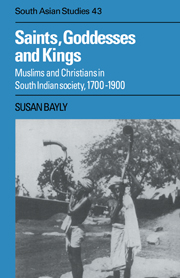Book contents
- Frontmatter
- Contents
- List of plates
- List of maps
- Preface
- Note on transliteration
- List of abbreviations
- Introduction
- Part I
- Part II
- 7 South Indian Christians in the pre-colonial period
- 8 The collapse of Syrian Christian ‘integration’
- 9 The Christian Paravas of southern Tamilnad
- 10 Christian saints and gurus in the poligar country
- 11 Christianity and colonial rule in the Tamil hinterland
- 12 Conclusion
- Select glossary
- Bibliography
- Index
- CAMBRIDGE SOUTH ASIAN STUDIES
- Plate section
9 - The Christian Paravas of southern Tamilnad
from Part II
Published online by Cambridge University Press: 04 December 2009
- Frontmatter
- Contents
- List of plates
- List of maps
- Preface
- Note on transliteration
- List of abbreviations
- Introduction
- Part I
- Part II
- 7 South Indian Christians in the pre-colonial period
- 8 The collapse of Syrian Christian ‘integration’
- 9 The Christian Paravas of southern Tamilnad
- 10 Christian saints and gurus in the poligar country
- 11 Christianity and colonial rule in the Tamil hinterland
- 12 Conclusion
- Select glossary
- Bibliography
- Index
- CAMBRIDGE SOUTH ASIAN STUDIES
- Plate section
Summary
Introduction
The Tamil Paravas are another of south India's maritime groups, but unlike the Syrians, they did not originate as a high-ranking service and trading community with a tradition of west Asian descent and migration. Instead the Paravas were once part of the low-ranking fishing and boathandling population of the south Indian coastline, and they adopted Christianity as clients of the Portuguese colonial authorities. As a result the Paravas can be grouped with the Tamil-speaking Muslim weavers, fishermen and traders of the Coromandel coast, and with the region's Tamil and Malayali-speaking Mukkuvas, most of whom also became Christian converts during the colonial period. Unlike these other maritime caste groups though, many of the people who came to be known as Paravas were able to move into more lucrative and prestigious occupations. By the late seventeenth and eighteenth centuries, the group had thrown up a powerful élite of maritime trading clans. This new wealth and the opulent caste lifestyle which it supported created a marked distinction between the Paravas and the poor and relatively homogeneous fishing communities of Malabar, Andhra Pradesh and the northern Tamil coast. So what did ‘conversion’ mean for such people, and what was the relationship between them and the surrounding society?
The Paravas owed their rise to an accident of geography. Their original homeland was the strip of coastline which runs along the Gulf of Mannar from southern Ramnad to the extreme tip of the Coromandel coast.
- Type
- Chapter
- Information
- Saints, Goddesses and KingsMuslims and Christians in South Indian Society, 1700–1900, pp. 321 - 378Publisher: Cambridge University PressPrint publication year: 1990



